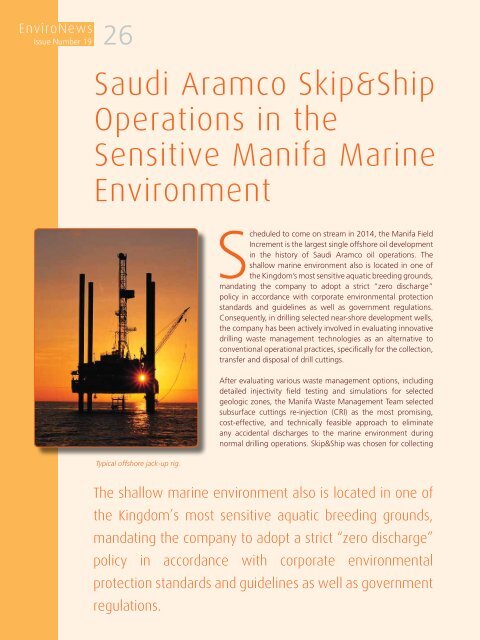Saudi Aramco Skip & Ship Operations in the Sensitive Manifa ...
Saudi Aramco Skip & Ship Operations in the Sensitive Manifa ...
Saudi Aramco Skip & Ship Operations in the Sensitive Manifa ...
- No tags were found...
You also want an ePaper? Increase the reach of your titles
YUMPU automatically turns print PDFs into web optimized ePapers that Google loves.
EnviroNewsIssue Number 1926<strong>Saudi</strong> <strong>Aramco</strong> <strong>Skip</strong>&<strong>Ship</strong><strong>Operations</strong> <strong>in</strong> <strong>the</strong><strong>Sensitive</strong> <strong>Manifa</strong> Mar<strong>in</strong>eEnvironmentTypical offshore jack-up rig.Scheduled to come on stream <strong>in</strong> 2014, <strong>the</strong> <strong>Manifa</strong> FieldIncrement is <strong>the</strong> largest s<strong>in</strong>gle offshore oil development<strong>in</strong> <strong>the</strong> history of <strong>Saudi</strong> <strong>Aramco</strong> oil operations. Theshallow mar<strong>in</strong>e environment also is located <strong>in</strong> one of<strong>the</strong> K<strong>in</strong>gdom’s most sensitive aquatic breed<strong>in</strong>g grounds,mandat<strong>in</strong>g <strong>the</strong> company to adopt a strict “zero discharge”policy <strong>in</strong> accordance with corporate environmental protectionstandards and guidel<strong>in</strong>es as well as government regulations.Consequently, <strong>in</strong> drill<strong>in</strong>g selected near-shore development wells,<strong>the</strong> company has been actively <strong>in</strong>volved <strong>in</strong> evaluat<strong>in</strong>g <strong>in</strong>novativedrill<strong>in</strong>g waste management technologies as an alternative toconventional operational practices, specifically for <strong>the</strong> collection,transfer and disposal of drill cutt<strong>in</strong>gs.After evaluat<strong>in</strong>g various waste management options, <strong>in</strong>clud<strong>in</strong>gdetailed <strong>in</strong>jectivity field test<strong>in</strong>g and simulations for selectedgeologic zones, <strong>the</strong> <strong>Manifa</strong> Waste Management Team selectedsubsurface cutt<strong>in</strong>gs re-<strong>in</strong>jection (CRI) as <strong>the</strong> most promis<strong>in</strong>g,cost-effective, and technically feasible approach to elim<strong>in</strong>ateany accidental discharges to <strong>the</strong> mar<strong>in</strong>e environment dur<strong>in</strong>gnormal drill<strong>in</strong>g operations. <strong>Skip</strong>&<strong>Ship</strong> was chosen for collect<strong>in</strong>gThe shallow mar<strong>in</strong>e environment also is located <strong>in</strong> one of<strong>the</strong> K<strong>in</strong>gdom’s most sensitive aquatic breed<strong>in</strong>g grounds,mandat<strong>in</strong>g <strong>the</strong> company to adopt a strict “zero discharge”policy <strong>in</strong> accordance with corporate environmentalprotection standards and guidel<strong>in</strong>es as well as governmentregulations.
27Summer 2010and transferr<strong>in</strong>g cutt<strong>in</strong>gs onshore while drill<strong>in</strong>g<strong>the</strong> CRI wells as well as a cont<strong>in</strong>gency backup <strong>in</strong>case of equipment failure dur<strong>in</strong>g <strong>in</strong>jection.The primary objectives of <strong>the</strong> planned operationwere to elim<strong>in</strong>ate any overboard dischargeswhile keep<strong>in</strong>g rig downtime to a m<strong>in</strong>imum.OperationFigure-1 is a schematic show<strong>in</strong>g <strong>the</strong> <strong>Skip</strong>&<strong>Ship</strong>process, from <strong>the</strong> collection of cutt<strong>in</strong>gs at <strong>the</strong> riguntil <strong>the</strong> f<strong>in</strong>al disposal at a marl-l<strong>in</strong>ed waste pitonshore designed for <strong>the</strong> transfer and disposalof waterbase mud (WBM) cutt<strong>in</strong>gs.1) Load empty skip on forklift2) Transfer empty skip on truck3) Delivery to port vessel/rig/vessel4) Vessel full skip to transport truck5) Unload full skip6) <strong>Skip</strong> dump<strong>in</strong>g at waste pitDisposal PlantFigure-2 shows <strong>the</strong> vacuum collection system(VCS) conveyance technology that is eng<strong>in</strong>eeredto collect, move, and store cutt<strong>in</strong>gs with<strong>in</strong>a totally enclosed environment to m<strong>in</strong>imizepotential spill, conta<strong>in</strong>ment, and safety issues<strong>in</strong>herent with “open” systems. Its versatilevacuum-fed rotary hopper allows for cont<strong>in</strong>uouscollection along with <strong>the</strong> nonstop discharge ortransfer of materials <strong>in</strong>to open-top slurrificationunits, standard cutt<strong>in</strong>gs skips, sturdy l<strong>in</strong>ed bags,or cutt<strong>in</strong>gs dryers.For <strong>the</strong> <strong>Manifa</strong> project, <strong>the</strong> VCS functions as<strong>the</strong> primary cutt<strong>in</strong>gs transportation packagefrom <strong>the</strong> shakers to <strong>the</strong> skip station. The system<strong>in</strong>stalled aboard a jack-up rig <strong>in</strong>cludes dual100-hp vacuums fed by tw<strong>in</strong> roto-hoppers tosupply <strong>the</strong> rig with a cont<strong>in</strong>uous vacuum. Twovacuums are required to handle <strong>the</strong> high rateof-penetration(ROP) <strong>in</strong> <strong>the</strong> upper hole sections.The VCS is able to fill four skips cont<strong>in</strong>uously,which m<strong>in</strong>imizes downtime wait<strong>in</strong>g for <strong>the</strong>crane.Figure-1. Schematic of <strong>Skip</strong>&<strong>Ship</strong> operation.Figure-3 shows <strong>the</strong> skips be<strong>in</strong>g transferred bycrane from <strong>the</strong> rig to <strong>the</strong> supply boat. To avoiddown time and issues related to limited space on<strong>the</strong> rig, it is important to monitor and schedule<strong>the</strong> transfer of skips. Typically, a total of 30 to40 skips are transferred dur<strong>in</strong>g one load<strong>in</strong>goperation. Then, <strong>the</strong> supply boat transfers<strong>the</strong> skips to <strong>the</strong> Tanajib facility for offload<strong>in</strong>g(Figure-4). Subsequently, <strong>the</strong> skips are loadedon trucks for transfer and disposal at <strong>the</strong> nearbywaste pit (Figure-5 and -6).Figure-2. Vacuum collection system (VCS).Figure-3. <strong>Skip</strong> transfer to supply boat.Figure-4. Transfer of skips to Tanajib facility.
EnviroNewsIssue Number 1928Figure-5. <strong>Skip</strong> transfer to waste pit.Figure-6: <strong>Skip</strong> unload<strong>in</strong>g at waste pit.Table-1 shows <strong>the</strong> estimated volumes by well hole size and required skips for a typical well. The totalvolume for <strong>the</strong> development well was approximately 2,700 tons, and more than 531 skips wererequired.Table-1. Cutt<strong>in</strong>gs volumes and skip requirements.Well Hole SizeSection Total Depth, ft (m)Section Volume (Tons)<strong>Skip</strong>s Used27 <strong>in</strong>1,110 (338 )4047822 <strong>in</strong>4,797 (1462)1,51129516 <strong>in</strong>5,984 (1824)3085912 ¼ <strong>in</strong>8,408 (2563)328638 ½ <strong>in</strong>9,543 (2909)19136SafetySafety and environmental protection are always<strong>the</strong> primary concerns dur<strong>in</strong>g any companyoperation. To date, despite severe wea<strong>the</strong>r andcont<strong>in</strong>ually chang<strong>in</strong>g drill<strong>in</strong>g conditions, <strong>the</strong>VCS system has been successful <strong>in</strong> collect<strong>in</strong>gand transport<strong>in</strong>g over 11,000 tons of cutt<strong>in</strong>gsfrom five offshore wells for land-based disposal.More importantly, even though more than8,200 crane lifts were required to transfer 2,100skips, no safety <strong>in</strong>cidents were recorded dur<strong>in</strong>gload<strong>in</strong>g, offload<strong>in</strong>g and transport<strong>in</strong>g operations.Fur<strong>the</strong>rmore, <strong>the</strong> VCS system cont<strong>in</strong>ues tooperate successfully on jack-up rigs, result<strong>in</strong>g<strong>in</strong> zero downtime dur<strong>in</strong>g rig operations, withm<strong>in</strong>imal ma<strong>in</strong>tenance required.SummaryThe VCS has been shown to be an excellentsystem for <strong>the</strong> safe, efficient transfer of largevolumes of WBM drill<strong>in</strong>g waste dur<strong>in</strong>g offshoredrill<strong>in</strong>g operations. Also, <strong>Skip</strong>&<strong>Ship</strong> is be<strong>in</strong>g usedas a cont<strong>in</strong>gency backup dur<strong>in</strong>g <strong>the</strong> ongo<strong>in</strong>g<strong>Manifa</strong> cutt<strong>in</strong>gs re-<strong>in</strong>jection (CRI) project. As<strong>the</strong> <strong>Manifa</strong> Project expands, it will be importantto utilize proven waste management systems toprotect <strong>the</strong> sensitive mar<strong>in</strong>e environment, meetcompany standards and guidel<strong>in</strong>es, and complywith str<strong>in</strong>gent government regulations.AcknowledgementsWe would like to thank those <strong>in</strong>dividuals fromall <strong>the</strong> contractors that were <strong>in</strong>volved alongwith Drill<strong>in</strong>g & Workover Services Department(D&WOSD), Drill<strong>in</strong>g Technical Department, and<strong>the</strong> Environmental Protection Department whohave supported <strong>the</strong>se successful operations.Submitted by Phil Gagnard and FalahAl-Herz (D&WOSD), Ahmed Baim(NAODD), Bruce Olson and ToddDugas (M-I Swaco).

















